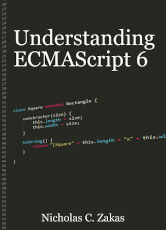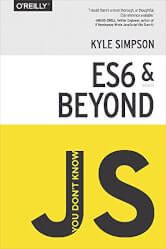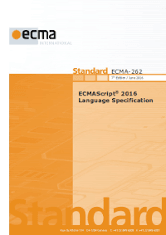Last Updated on October 25, 2024
ECMAScript is an object‑oriented programming language for performing computations and manipulating computational objects within a host environment. The language was originally designed as a scripting language, but is now often used as a general purpose programming language.
ECMAScript is best known as the language embedded in web browsers but has also been widely adopted for server and embedded applications.
Here’s our recommended texts to learn this language. They are all free to read, and a few are open source licensed.
1. Understanding ECMAScript 6 by Nicholas C. Zakas

Understanding ECMAScript 6 is a guide for the transition between ECMAScript 5 and 6. It is not specific to any JavaScript environment, so it is equally useful to web developers as it is Node.js developers.
This book is targeted at intermediate-to-advanced JavaScript developers programming for a browser or Node.js environment who want to learn about the latest developments in the language.
Each of this book’s thirteen chapters covers a different aspect of ECMAScript 6.
Readers learn about:
- All of the changes to the language since ECMAScript 5.
- How the new class syntax relates to more familiar JavaScript concepts.
- Why iterators and generators are useful.
- How arrow functions are differ from regular functions.
- Additional options for storing data using sets, maps, and more.
- The power of inheriting from native types.
- Why people are so excited about promises for asynchronous programming.
- How modules will change the way you organize code.
The book is published under the Creative Commons Attribution-NonCommercial-NoDerivs 3.0 Unported (CC BY-NC-ND 3.0) license.
2. You Don’t Know JS (book series) by Kyle Simpson
 This book teaches you how to:
This book teaches you how to:
- Learn new ES6 syntax that eases the pain points of common programming idioms.
- Organize code with iterators, generators, modules, and classes.
- Express async flow control with Promises combined with generators.
- Use collections to work more efficiently with data in structured ways.
- Leverage new API helpers, including Array, Object, Math, Number, and String.
- Extend your program’s capabilities through meta programming.
- Preview features likely coming to JS beyond ES6.
ES6 & Beyond is part of a series of books examining the core mechanisms of JavaScript.
All books in the series are published under the Creative Commons Attribution-NonCommercial-NoDerivatives 4.0 International License.
3. Standard ECMA-262 ECMAScript 2016 Language Specification by Ecma International
 This Standard defines the ECMAScript 2019 general-purpose programming language.
This Standard defines the ECMAScript 2019 general-purpose programming language.
ECMAScript is based on several originating technologies, the most well-known being JavaScript (Netscape) and JScript (Microsoft). The language was invented by Brendan Eich at Netscape and first appeared in that company’s Navigator 2.0 browser. It has appeared in all subsequent browsers from Netscape and in all browsers from Microsoft starting with Internet Explorer 3.0.
The book is released under an open source license.
Next page: Page 2 – Speaking JavaScript and more books
Pages in this article:
Page 1 – Understanding ECMAScript 6 and more books
Page 2 – Speaking JavaScript and more books
All books in this series:
| Free Programming Books | |
|---|---|
| Ada | ALGOL-like programming language, extended from Pascal and other languages |
| Agda | Dependently typed functional language based on intuitionistic Type Theory |
| Arduino | Inexpensive, flexible, open source microcontroller platform |
| Assembly | As close to writing machine code without writing in pure hexadecimal |
| Awk | Versatile language designed for pattern scanning and processing language |
| Bash | Shell and command language; popular both as a shell and a scripting language |
| BASIC | Beginner’s All-purpose Symbolic Instruction Code |
| C | General-purpose, procedural, portable, high-level language |
| C++ | General-purpose, portable, free-form, multi-paradigm language |
| C# | Combines the power and flexibility of C++ with the simplicity of Visual Basic |
| Clojure | Dialect of the Lisp programming language |
| ClojureScript | Compiler for Clojure that targets JavaScript |
| COBOL | Common Business-Oriented Language |
| CoffeeScript | Transcompiles into JavaScript inspired by Ruby, Python and Haskell |
| Coq | Dependently typed language similar to Agda, Idris, F* and others |
| Crystal | General-purpose, concurrent, multi-paradigm, object-oriented language |
| CSS | CSS (Cascading Style Sheets) specifies a web page’s appearance |
| D | General-purpose systems programming language with a C-like syntax |
| Dart | Client-optimized language for fast apps on multiple platforms |
| Dylan | Multi-paradigm language supporting functional and object-oriented coding |
| ECMAScript | Best known as the language embedded in web browsers |
| Eiffel | Object-oriented language designed by Bertrand Meyer |
| Elixir | Relatively new functional language running on the Erlang virtual machine |
| Erlang | General-purpose, concurrent, declarative, functional language |
| F# | Uses functional, imperative, and object-oriented programming methods |
| Factor | Dynamic stack-based programming language |
| Forth | Imperative stack-based programming language |
| Fortran | The first high-level language, using the first compiler |
| Go | Compiled, statically typed programming language |
| Groovy | Powerful, optionally typed and dynamic language |
| Haskell | Standardized, general-purpose, polymorphically, statically typed language |
| HTML | HyperText Markup Language |
| Icon | Wide variety of features for processing and presenting symbolic data |
| J | Array programming language based primarily on APL |
| Java | General-purpose, concurrent, class-based, object-oriented, high-level language |
| JavaScript | Interpreted, prototype-based, scripting language |
| Julia | High-level, high-performance language for technical computing |
| Kotlin | More modern version of Java |
| LabVIEW | Designed to enable domain experts to build power systems quickly |
| LaTeX | Professional document preparation system and document markup language |
| Lisp | Unique features - excellent to study programming constructs |
| Logo | Dialect of Lisp that features interactivity, modularity, extensibility |
| Lua | Designed as an embeddable scripting language |
| Markdown | Plain text formatting syntax designed to be easy-to-read and easy-to-write |
| Objective-C | Object-oriented language that adds Smalltalk-style messaging to C |
| OCaml | The main implementation of the Caml language |
| Pascal | Imperative and procedural language designed in the late 1960s |
| Perl | High-level, general-purpose, interpreted, scripting, dynamic language |
| PHP | PHP has been at the helm of the web for many years |
| PostScript | Interpreted, stack-based and Turing complete language |
| Prolog | A general purpose, declarative, logic programming language |
| PureScript | Small strongly, statically typed language compiling to JavaScript |
| Python | General-purpose, structured, powerful language |
| QML | Hierarchical declarative language for user interface layout - JSON-like syntax |
| R | De facto standard among statisticians and data analysts |
| Racket | General-purpose, object-oriented, multi-paradigm, functional language |
| Raku | Member of the Perl family of programming languages |
| Ruby | General purpose, scripting, structured, flexible, fully object-oriented language |
| Rust | Ideal for systems, embedded, and other performance critical code |
| Scala | Modern, object-functional, multi-paradigm, Java-based language |
| Scheme | A general-purpose, functional language descended from Lisp and Algol |
| Scratch | Visual programming language designed for 8-16 year-old children |
| SQL | Access and manipulate data held in a relational database management system |
| Standard ML | General-purpose functional language characterized as "Lisp with types" |
| Swift | Powerful and intuitive general-purpose programming language |
| Tcl | Dynamic language based on concepts of Lisp, C, and Unix shells |
| TeX | Markup and programming language - create professional quality typeset text |
| TypeScript | Strict syntactical superset of JavaScript adding optional static typing |
| Vala | Object-oriented language, syntactically similar to C# |
| VHDL | Hardware description language used in electronic design automation |
| VimL | Powerful scripting language of the Vim editor |
| XML | Rules for defining semantic tags describing structure ad meaning |
